Though it is a sleepy destination compared to most of the other locations throughout the Caribbean, it is an easy place to visit. Cruise ships have recently added Dominica to their itineraries, and commercial flights are being added daily. While its residents are not as well known as some of the great musicians and athletes who have come from Jamaica, Dominica has had its share of cultural influencers, such as novelist Jean Rhys, NBA basketball player Garth Joseph, Dame Mary Eugenia Charles, first woman prime minister in the Caribbean, along with musicians Prince Ital Joe and Gordon Henderson from Exile One.
| KEY FACTS | |
|---|---|
| Size | 290 square miles (750 square kilometers) |
| Population (2016) | 73,543 (as of 2001 86.6% Black, 9.1% multiracial, 2.9% Carib, 1.5% European and other) |
| Status | Parliamentary republic |
| Official language(s) | English, French Creole |
| GDP per capita (2018) | $6,860 |
| Currency | Eastern Caribbean dollar pegged to US dollar |
| Electricity | UK standard three-prong |
| Driving | on the left |
Dominica is certainly not the most popular island, but it offers just as many distinct and exciting experiences that can be found throughout the Caribbean. It is not to be missed for those who are interested in experiencing rainforests and catching a glimpse of birds and wildlife that can only be found in Dominica.
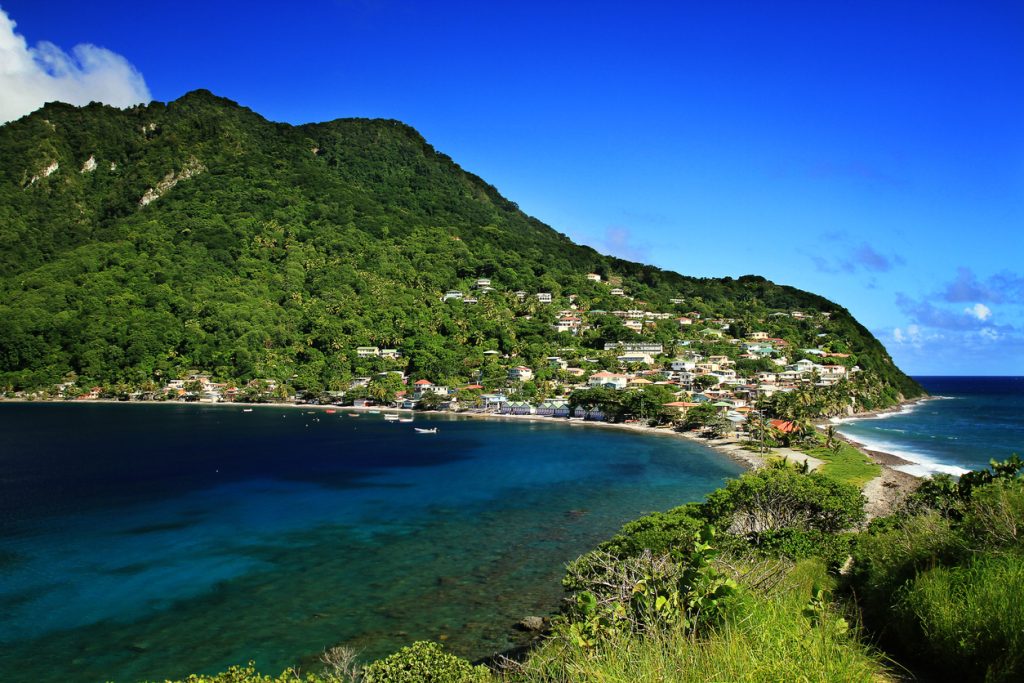
Getting there
Dominica’s reputation as a largely untouched island makes it a popular destination, but it also makes getting there a little more challenging. Neither of the two airports receive international flights, so visitors must fly in from one of the other nearby islands, such as Guadeloupe, Barbados or Martinique, or larger cities such as San Juan or Puerto Rico. The main airport, Douglas-Charles Airport (DOM), is about an hour from Roseau by car and about forty-five minutes from Portsmouth. Canefield Airport (DCF) is much closer to the main city, but due to its small size, Douglas-Charles id better suited for commercial flights. Half a dozen airlines offer daily service on and off the island.
For those interested in making Dominica a stop on their Caribbean cruise, Roseau has recently expanded their port to accommodate some of the largest cruise ships sailing the seas.
Getting around
Because Dominica is one of the most pristine and well-preserved locations in the Western Hemisphere, it remains largely undeveloped. This makes travelling the rough terrain challenging and slow. Because most of the island’s main attractions are spread out, renting a car or hiring a taxi is necessary if you’re interested in leaving the city of Roseau.
The island is still recovering from the damage Hurricane Maria caused in September of 2017. Potholes, mountain passages with thick vegetation, and roads still under repair make driving on the island a daunting task. In addition to being comfortable with these adverse conditions, you should also be capable of driving on the left side. If you’re intent on exploring the island on your own, it is highly recommended to rent a vehicle with four-wheel drive. Most of the roads run along the coastline or along rivers, but there is a lack of signage, and very little lighting, which makes driving after dark dangerous. Even residents of the island are intimidated by the narrow, winding roads. Driving in Dominica requires a permit, which costs about 30 East Caribbean dollars ($12 US dollars). It can be purchased at rental agencies, and the Traffic Department office located in the downtown area of Roseau.
Although taxis are more expensive than minibuses, they are the only way you’ll be able to reach most of the activities on the island if you’re not planning to rent a car. Limited public transportation is only available within the main cities. Taxis can be hired for the day, and riding with other passengers is a good way to mitigate the cost. Reservations for travel afterhours are highly recommended.
Things to explore
For those who are interested in spending their vacation walking through beautiful landscapes and hidden pockets of natural wonder, Dominica is a must-see island in the Caribbean. Almost all of the top attractions in Dominica are located outdoors.
- Morne Trois Pitons National Park – The only UNESCO World Heritage Sites in the Eastern Caribbean, Morne Trois Pitons, which translates into “Mountain of Three Peaks,” was designated a National Park in 1975. It’s a vast mountain rainforest with an abundance of rivers, waterfalls, animals, birds and plant species, many of which are extinct elsewhere. Titou Gorge is where the Pirates of the Caribbean: Dead Man’s Chest “Cage of Bones” drop scene was filmed. Expect to pay a small fee (5USD per person) to access the park.
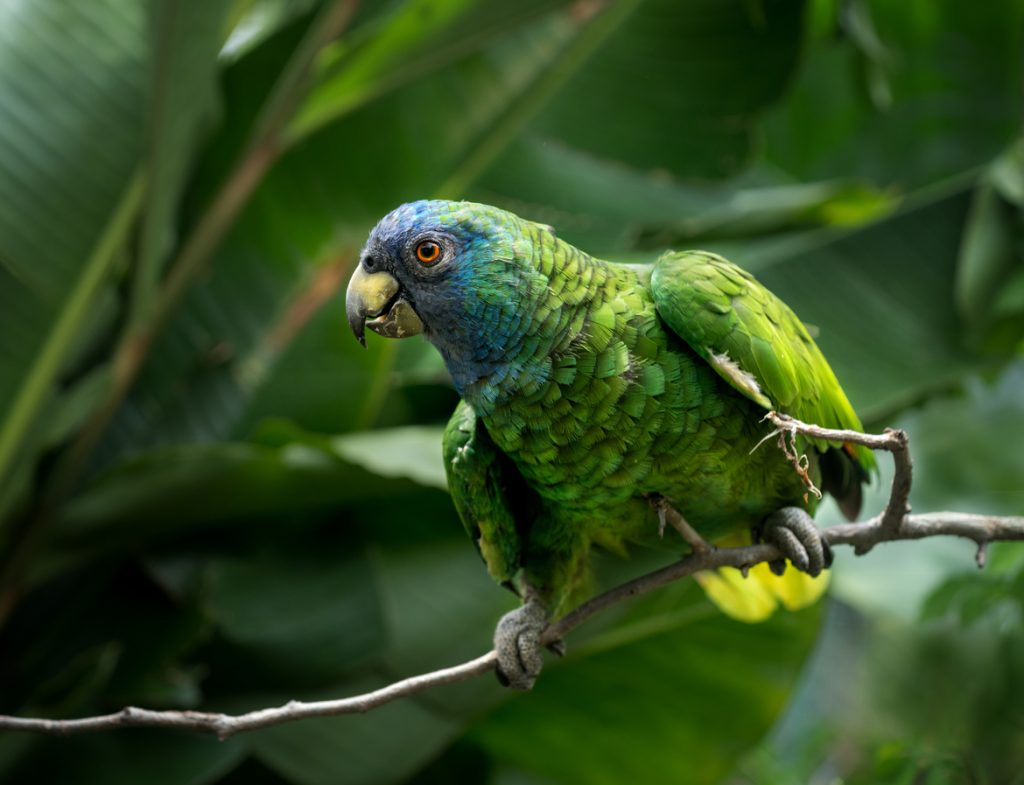
- Boiling Lake – Located within Morne Trois Pitons National Park, Boiling Lake was discovered in 1870. It rest at the bottom of a basin, and is considered the second-largest hot lake in the world. The pool, that is roughly 200 feet (61 m) across, is filled with bubbling greyish-blue water and sits beneath a cloud of vapor. The only way to see the Boiling Lake is to make the 4 mile (13 km) hike that starts in Laudat, by Tito Gorge. It will also take you up the mountain Morne Nicholls and end at the top of the Valley of Desolation. It should be noted that this is a challenging hike with several areas that require extra caution, and is best explored with the help of a guide.
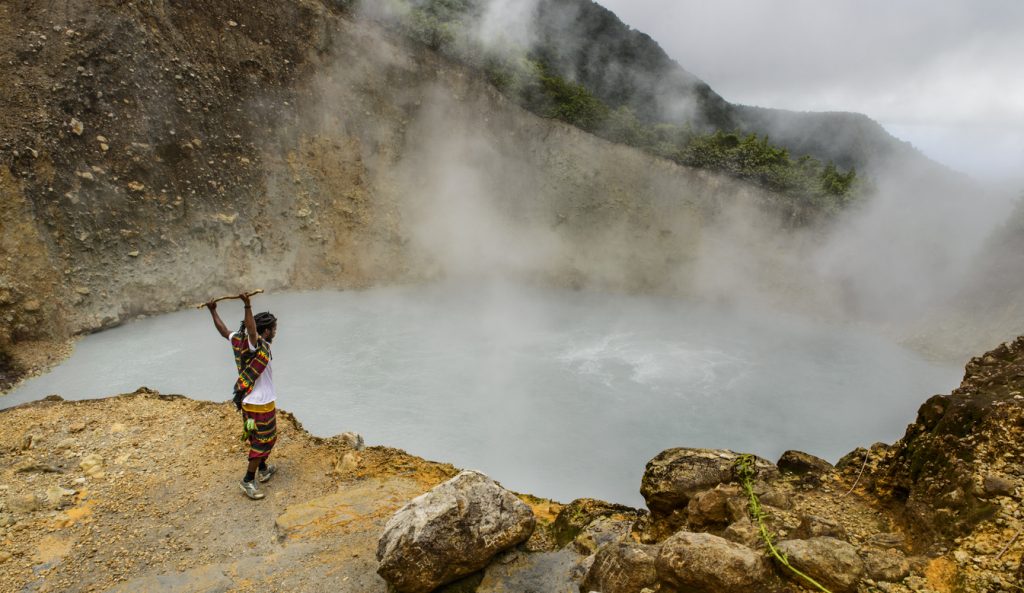
- Victoria Falls – Located near the village of Delices, this 165 ft (50 m) high waterfall originates from the Boiling Lake and feeds into the White River on the southeast side of the island. The 45-minute hike requires traversing several rivers. It’s manageable by most children over the age of 8, but hikers should be aware of slippery rocks and large boulders that require some climbing. Due to the overgrown conditions, a guide is highly recommended. As is a swimsuit. The end of the hike requires crossing a pool that is 5-7 feet deep, but the water conditions are so enjoyable, you’ll likely want to stay for a while.
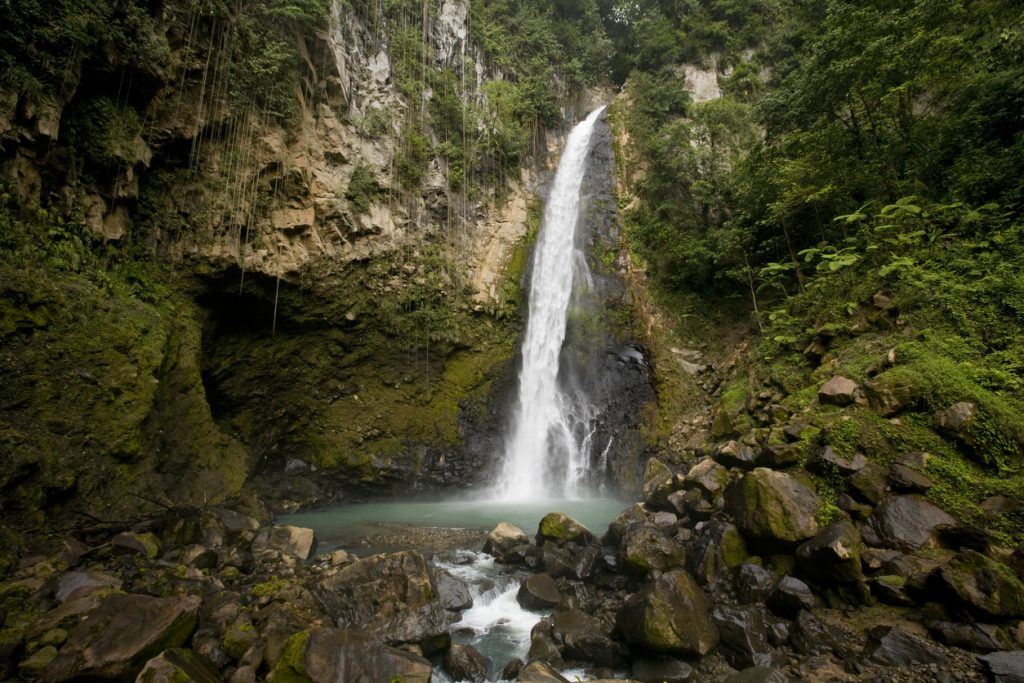
- Trafalgar Falls – Located about 20 minutes from Roseau by car, are Dominica’s famous twin falls. This is a very popular destination not only for its unique beauty, but because it’s extremely family friendly. A beautiful reception area that is perfect for taking photos is just a short 15-minute walk along a gentle pathway. The more dramatic, upper waterfall referred to by locals as “Father,” lies between the Boiling Lake and the White River, while the lower waterfall, “Mother” flows gently from a river into a natural swimming pool. More adventurous visitors might want to consider bringing swim gear and hiking to the base of the falls.
- Papillote Tropical Gardens – Located just before the trailhead to Trafalgar Falls, these gardens, which take up 14 acres of land, are home to extremely rare plants and wildlife. While guided tours are available, they are not required. Visitors are welcome to walk the grounds on their own. There is a nearby restaurant, as well as a hot pool that is open to those looking to take a quick dip in warm water.
- Cabrits National Park – Located at the most northern part of the island, this national park, which is roughly 1,313 acres (531 ha) is situated at the end of a peninsula. It is an extinct volcano that used to be independent of the island, but debris from Douglas Bay eventually created a land bridge, so it’s now considered to be part of the country. Tropical forests, coral reefs and wetlands are all contained within the National Park, as are many endangered species that have since become extinct on other islands. There are many hiking trails, including one that leads out to Fort Shirley, an18th-century British garrison, that has been impressively restored.
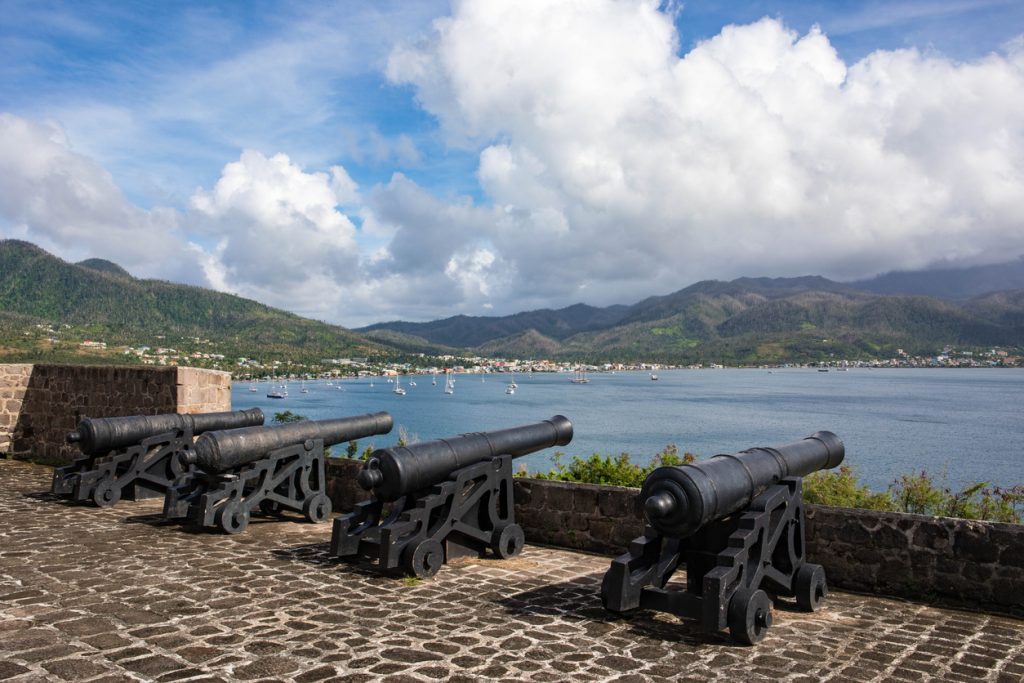
- Roseau – the Island’s main city (and nation capital) is home to 25,000 people. This largely urban sprawl is where you’ll find a lot of modern conveniences as well as unique examples of Dominica’s cultures. Situated on the western coastline, there is no shortage of beautiful sunsets to end the day. The French colony influence can be seen in the way the streets fan out from the central location of the Old Market. For those who don’t want to leave the city, but are interested in a taste of nature, the Botanical Gardens are an example of how the country caters to the eco-tourist. Dominica is the only island that has such extensive greenery right in the middle of the city. There is an abundance of distinct architecture and no shortage of buildings that trace Roseau’s varied past. You can easily find examples of creole, West Indian, English colonial, Gothic Romanesque, and French Colonial, on a casual walk around the city.
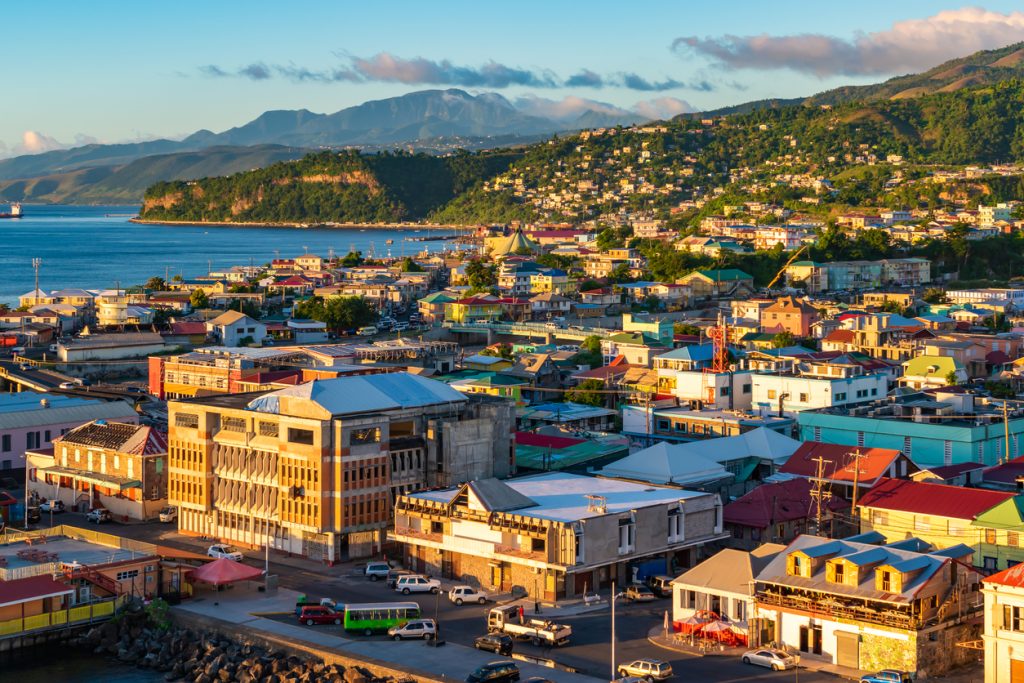
Accommodations
Dominica prides itself upon its natural beauty, and therefore has been slow to develop. The main draw is eco-tourism, which attracts a different kind of visitor. This has resulted into a very select roster of accommodations. Those looking for the larger chain resorts will be disappointed, because there are none located anywhere around the island. That said, there are plenty of places to stay that will appeal to every kind of traveler and every kind of budget, all the way from picturesque five-star luxury resorts and hotels, to hostels and campgrounds.
Roseau is where you’ll find the greatest variety of lodging. Because of its dense population, there are a lot of affordable accommodations. Hostels and guesthouses, like St. James, start around 50USD per night, whereas the Fort Young Hotel, built on a cliff that overlooks the water, will cost you upwards of 130USD per night. While there are several mid-range hotels along the coast, the most interesting lodging can be found scattered throughout the rest of the island. Secret Bay, which is true to its name, is just outside of Portsmouth on the Northwest part of the island. It’s a cluster of luxury bungalows and villas built into the lush cliff landscape with private beach access and spa amenities, including a yoga class. Expect to pay around 1000USD per night.
For the eco-tourist, there are several unique options that will give you the feeling of sleeping in nature. Located on the southeast side of the island near the White River in the Morne Trois Piton National Park, the Jungle Bay Resort and Spa is a collection of 35 tropical hardwood cottages nestled amongst the trees. At the affordable price point of about 250USD, at Jungle Bay you can not only order a fresh, organic juice from the onsite restaurant, you can feel like you’re in your own private tree house.
Food & Restaurants
The main staple of Dominica cuisine is seafood. While it’s found on all Caribbean island menus, fish prepared in a variety of ways – baked, dried, salted, fried – is eaten for breakfast, lunch, and dinner. Street food within the city of Roseau is prevalent and always available. Expected fare, such as plantains, yams, potatoes and porridge are readily available, and are quite inexpensive. Stews made of chicken, beef and fish are very popular, as are yogurt smoothies made from fruit picked fresh every day.
Local cuisine can be enjoyed at a variety of restaurants and range from 10USD to 20USD per entrée. The same variety of architectural styles that can be found throughout the city is matched only by different types of cuisine located around the island, from British, French, American, Vegetarian and everything in between. Fine dining options prepared by globally trained master chefs provide upscale surroundings and offer complex dishes that will impress even the most discerning palate. Most have incredible views of the ocean. The Coral Reef Restaurant is right on the beach, as is the Sunset Bay Club’s Lobster Palace. Old Stone Grill and Bar is also an art gallery and has both indoor and outdoor seating. There are a number of well-stocked grocery stores, but they are mainly located within the city.
Nightlife
Nightlife is not one of the more vibrant aspects of Dominica. There are certainly places to drink and dance well into the evening, such as Symes Zee’s where you can find live jazz bands playing any night of the week, the majority of evening entertainment will usually be hosted by your resort. Jing Ping is Dominica’s folk music that originates from the plantations back in the days of slavery. It consists of an accordion band and a circle dance. It’s considered a traditional experience, but will have you up and dancing regardless where you’re from.
Cadence-lypso is a more modern style of music that’s well known around the world. Roseau native, Gordon Henderson, founded Exile One in 1969. The band went on to sell gold records before it morphed into a new group, Roots of Exile, and invented the new style of music called Island Boogie, that incorporates elements of North American funk and soul. Roots of Exile represented Dominica well, touring Africa, Europe and Asian countries throughout the 1980s.
Depending on when you visit, you might be able to attend the annual three-day World Creole Music Festival. Recurring since 1997, WCMF is a great way to enjoy international acts that come from all over the world. Past performers have included Exile One, Tabou Combo, Ophelia Marie, and Francky Vincent, to name a few. It’s definitely an argument for planning your trip during the month of October. For those who visit in the summer months, the Jazz’n Creole Festival at Fort Shirley in Cabrits National Park, offers music and food from all over the island.
Sports & adventures
There is no shortage of exciting sports and adventures to be found in Dominica, but it is not a destination for those looking to have a typical resort style experience. Organized tours and experiences are available, but since there is no one-size-fits-all when it comes to exploring Dominica, it will mostly be left up to you to decide what you want to do.
- Champagne Reef – Dominica is the smallest, most recently formed island of the Lesser Antilles archipelago and is still experiencing seismic activity. This is what makes Champagne Reef so special. It’s known as a premier diving and snorkeling destination, not only within the Caribbean Islands, but also around the world. The colors are incredible, with saltwater fish of all shades and hues darting through coral structures, but what makes Champagne Reef unlike other places are the thousands of small bubbles that rise up through the lava rock bottom. It’s also home to a dazzling array of sponges in colors not found elsewhere throughout the island. Creature sightings have included seahorses, octopus, rays, parrotfish and turtles.
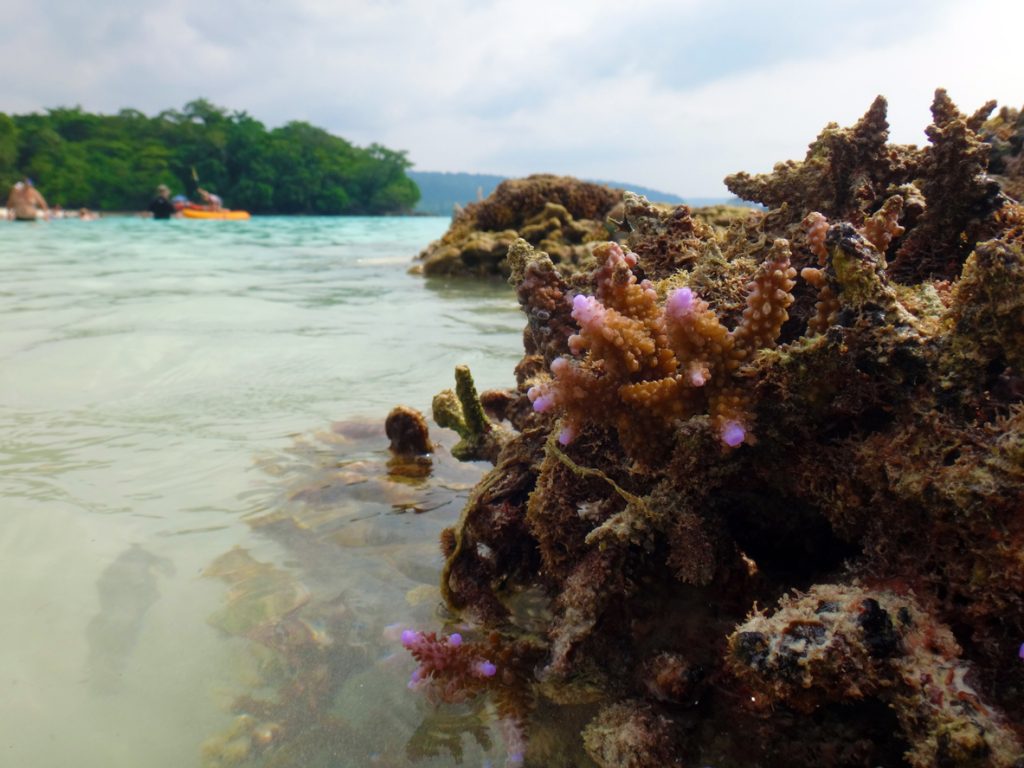
- Hiking – Hiking is hard to avoid when staying in Dominica. Pretty much everywhere you go outside of the main cities requires some form of hiking to get where you want to go. For those who are looking for more than just an easy walk, consider canyoning. With so many rivers, gorges, boulders, waterfalls, and rainforests, some of the most spectacular and challenging canyoning can be found in Dominica.
- Waitukubuli National Trail – It has been said that the best way to avoid hotel prices is to spend your vacation hiking Waitukubuli. The 114 mile trail stretches from north to south and winds through some of the most popular destinations on the island. You’ll get a taste of every scenic view Dominica has to offer, as you pass through villages located on the seaboard, and hike up to the tops of mountains. There’s no shortage of waterfalls, rainforests, hills, coastline, and rivers. The trail requires a pass visitors must purchase, but when you consider how much you’ll see – including traditional Kalinago villages, old French settlements, and secret passages that allowed runaway slaves to escape captivity – the price is well worth it. A single segment costs about 12USD, while the full 15-day pass will cost about 40USD. There are 14 segments to the trail, all which can be completed within 7 hours at the most. Some parts of the hike are gentler than others, and places to stay at each segment are designed to accommodate every guest who passes through.
- Whale Watching – Anyone who has seen old pencil sketches made by Caribbean explorers during the 17th and 18th centuries have certainly seen images of sperm whales. With their squared off head and long slender body, these creatures, who are the largest toothed whale species, live here year-round. In addition to Melville’s Moby Dick, watchers can also catch a glimpse of the spotted dolphin, Fraser’s dolphin, the bottlenose dolphin and the short-finned pilot whale. Depending on the season, you might also be able to see humpback whales, killer whales, and several species of beaked whales.
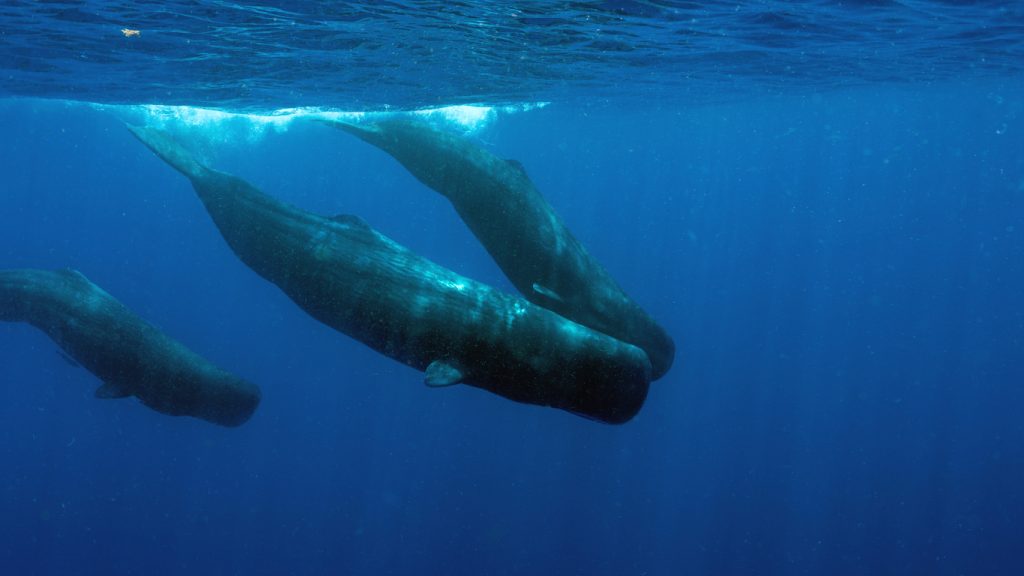
Safety and security
Being one of the ‘quieter’ islands in the Caribbean, Dominica crime is very low compared to other places throughout the region, although incidents do occur. It’s always important to maintain a level of awareness and be cautious whenever exploring the city. It’s wise to make note of important embassy numbers, and to follow the general rules of travel, such as securing your belongings, traveling with minimal cash and always having your passport handy.
The main concern for safety on the island of Dominica is taking precautions while exploring the natural landscape. Complex hiking trails with dense vegetation and little markings, rivers and waterfalls where flash flooding can occur during inclement weather, and the risk of injury from slipping or falling are important things to consider when planning your activities. It’s always a good idea to make sure someone knows your itinerary for the day, and it always encouraged hiring a professional guide, no matter where you’re planning to visit or what you’re planning to do.
Are these the Caribbean’s best hikes?
Stretch your legs and take a walk: the Caribbean’s magnificent scenery lends itself to exploring…

